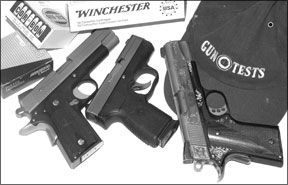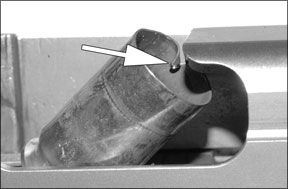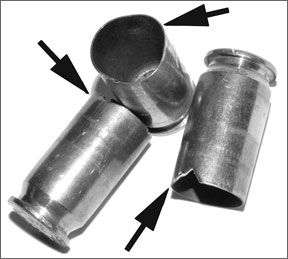An the opinion of many experienced shooters, the 45 Auto is the caliber of choice in self-defensive pistols. However, most of these guns, like the classic 1911 Colt, are big and heavy. Therefore, they often get left behind for a lighter piece, which generally is of lower power. If you still want the power of a 45, why not go to a smaller and lighter gun?

We found three such pistols for this test, and gave them a wring-out. They were a Colt CCO, no longer in the Colt stable but available on the used or new-old-service market for about $1250, depending on condition; the recently introduced SIG Sauer 1911 C3 No. 19GS0031, $1143; and a new PM45-series pistol from Kahr, the PM4543, $855. The Kahr was not quite the same setup but clearly had the same intent as the other two, to deliver big power in a smaller, lighter package.
Both the SIG and Colt had aluminum frames, and they featured the old Colt Officer’s Model handle with the Commander-length slide. Most of our test group believes this is the ideal setup for a 1911-type 45 auto, but those with large, wide hands might prefer a gun like the lightweight Commander, which has a bigger grip. The Kahr had its usual ergonomically designed polymer grip with stainless slide, and of course was DAO. We tested with three types of ammunition, Federal 185-grain Hi-Shok JHP, Federal 230-grain ball, and with Cor-Bon 185-grain JHP. We also tried a few groups with Federal Gold-Medal Match, 185-grain TC bullets. Here’s what we found.
Colt CCO 45 ACP, $1250
The Colt CCO, which stands for “Concealed-Carry Officer’s,” was the first pistol, we believe, to use the combination of the short Officer’s Model grip and the longer Commander slide. The gun came out in the early 1990s. That combination made perfect sense then and still does today. The grip is the item that usually gives the most problems with concealment. The barrel could be a foot long and still would conceal easily in any holster that generally aligned the barrel with the upper leg, or with the torso in a shoulder rig. The only other problems with packing a 45 were the weight of the general-issue, full-size model, and the recoil of any 45 light enough to carry easily. An aluminum-alloy frame would solve the first problem, and in our experience, the recoil level of the lighter 1911s is not a major factor for experienced shooters.
Our test Colt dates to about 1995. It’s marked “Colt Mk IV Series 80” on the left side of the matte-stainless slide, and “C.C.O.” on the right. The top of the 4.25-inch barrel has “COLT 45 AUTO” over the chamber. The top of the slide has a raised rib, into which the front sight is dovetailed. The rear of the slide has a Novak sight installed. The rear notch was marked with two orange-colored tritium inserts, and the well-sloped, serrated front sight had a green tritium insert. We found this to be an excellent combination, less confusing, in our opinion, than all-green sights.
Its owner did some engraving to the slide and frame, and added crosswise serrations to the top rib. Then he sent it to Coating Technologies, Inc., (www.coatingtechnologiesinc.com) to have some of the innards treated with NP 3, which will prevent corrosion forever. The owner also saw fit to dehorn the outside here and there, the original Colt having had numerous sharp corners that did not belong. The worst offender was the front of the slide, where it cut the holster on reinsertion. The result is a handgun you can’t buy new, and even on the used market you might have a lot of trouble finding a CCO today. The most recent offering by Colt was the CCO Gunsite version, which you might still find for sale with a diligent search and a lot of luck. It listed for about $1250, but Colt dropped it from its inventory several years ago. It seems the owners of CCOs don’t let them go. As such, we wonder why no other maker but SIG has offered a package like this. Could it be shooters just don’t know about ‘em? There are several similar handguns being offered by various makers, but none except the SIG Sauer 1911 C3 has the overall package quite as right as Colt had it, in our opinion.
This CCO originally had wrap-around, rubber, finger-grooved grips. These got ripped off, the owner told us, as soon as the fine Ahrends Tactical ones arrived. He said they were a vast improvement, but said grips like the ultra-thin ones on the SIG C3 would today be his preferred choice. We note that Ahrends (ahrendsgripsusa.com) now makes thin ones in a variety of woods and synthetics, as do several other makers.
The CCO had an extended one-side-only grip safety. It came with two seven-shot magazines. The gun had a beavertail extension, a plastic, checkered mainspring housing, no checkering on the front strap, and no beveling on the magazine opening. The Colt CCO seemed to be a good idea that needed refining, from what we understand of the original CCO setup. In our opinion, the SIG Sauer C3 took the same idea and ran hard with it. More on that later.
The slide had no forward serrations, so we used the old press-check method to verify an empty chamber. Takedown was classic 1911. The barrel had six grooves and lands in a left-hand twist. We also found the unpopular Colt flip-up firing pin lock, activated by the trigger on Series 80 Colts. Despite that, the gun had an excellent trigger pull of 4.5 pounds. Workmanship, fit and finish were excellent inside and out. We put the gun together and headed for the range.
Our first shots told the story. Accuracy was very good, and impact was right on the money. Recoil was not much of a problem, even with the hottest Cor-Bon 185-grain load. Our best five-shot group was 1.6 inches with 230-grain Winchester ball. We had exactly no trouble with feed, fire, or function with any loads in the CCO. About the only things we came close to disliking were the fully functional but plastic mainspring housing and, after handling the Sig, the normal-thickness grips. Both of these can be changed, but neither needs to be. We handled, and hated, the original rubber grips.
SIG Sauer 1911 C3 No. 19GS0031 45 ACP, $1143
As detailed above, some of us had come to believe the Colt CCO was the finest 45 available. However, the last version of it, called the Gunsite number O9840CGP, is now discontinued. But fear not, the SIG Sauer 1911 C3 is here, and is an even better, more refined version of the CCO. And it’s cheaper.
Our first impression of the SIG C3 was that someone had stolen the CCO we had on hand, and had copied it in great detail. Only the engraving was missing. Then we noticed some differences, and on inspection these became very significant, entirely in the favor of SIG Sauer. First up were the thin grips. After handling the CCO we grasped the C3 with its grip of slim, fancy-wood panels, and immediately liked it. These make the gun feel smaller and lighter, and about half as thick as the CCO. The slim grip panels were checkered in a pleasing pattern that left smooth wood under the thumb and index finger.

The mainspring housing was checkered steel, not plastic. The frame also had a finely checkered front strap, something lacking—and needed—on the CCO. The well-done handle of the C3 put the Colt in second place, said our test crew. The entire gun had been dehorned, just like all the aftermarket work done to the CCO by its owner. There were no offending sharp edges anywhere. There was an external extractor behind the ejection port. The slide was matte stainless, with a smooth top that lent distinction to the overall look of this pistol. It was our impression the setup of this gun had been influenced by the experiences of real-world shooters, not corporate executives.
The dovetailed front sight of the SIG was not as slanted at its rear as that of the CCO, so we expected it to grab on the front of our Bachman Slide. It did. Ordinary holsters won’t have that problem. The rear sight was a Novak, adjustable by drifting, and locked with a small Allen screw. The sights had green tritium inserts, and the sight picture was excellent.
Takedown was classic 1911. As on the CCO, there was no spring rod at the front, and we had no trouble at all taking this fine handgun apart nor in putting it back together. Fit and finish inside and out were outstanding, superior to that of the Colt and Kahr. To our surprise we found a firing-pin lock in the Sig’s slide.
On the range, the 4.6-pound trigger felt about as good as that of the CCO. Recoil was essentially identical, but accuracy with all loads was superior to that of the CCO. Our best groups were clusters around an inch with Winchester 230-grain ball. We had one failure to feed with Cor-Bon 185-grain ammo, the only failure with this handgun. Accuracy with Cor-Bon in this gun was the worst of any ammo tried. Yet Cor-Bon gave the finest (qualified) accuracy with the Kahr. Obviously any serious handgun needs serious testing with your chosen ammo.

Kahr PM4543 45 ACP, $855
At first look, we liked what we saw in the Kahr Model PM4543, as it is officially known. We found excellent Kahr workmanship, a great-feeling grip, and a decent, clean, useable DAO trigger, even if a bit stiffer than the triggers of the other two guns. It broke at 6.1 pounds. The two magazines that came with it each held only five rounds, which gave the nod by two to the other design. Still, 5+1 might be enough. The sights were excellent, and the two-tone finish was well done, about as good as on the other pair of test pistols. The grip and frame were polymer, with suitable steel inserts at wear points. The slide was matte-finish stainless, and the thick magazine bottom added size and comfort. For an extra $120 you can have the PM45 with tritium sights. The gun could be fired with the magazine removed, like the other two pistols.
Takedown was not difficult, but could have been made easier. Per the Kahr website video (kahr.com), you must first unload the gun and remove the magazine. Then align a mark on the slide with one on the frame, pulling the slide back against the recoil spring. These alignment marks are on the left side of the gun. Then you are then instructed to turn the gun over, maintaining that now-invisible alignment, and rap the protruding end of the slide stop to start it out of the gun. Seems to us the alignment marks ought to have at least been repeated on the right side, to make this task easier, because with this handgun you’re fighting a strong recoil spring. Pull the slide stop completely out of the gun. Then, press the trigger and pull the slide forward to remove the slide from the frame. Remove the compressed dual-concentric spring assembly and barrel, and that’s it. Reassembly was just as straightforward. Note that the inner of the two recoil springs can’t be readily removed. The rather brutal spring assembly came out much easier than we expected, and gave no problems in going back in.
We found very good workmanship inside with one exception. The forward-most lip of the plastic guide rail, on the right side, showed some cutting or wear on its lower edge. The cause for this seemed to be the rearmost protrusion inside the slide, which was shaped about like a cutting tool on a lathe. If the soft frame were repeatedly rubbed against this while being twisted, the result could be the severe wear on the plastic we observed. We found it when we first took the gun apart. It seemed the gun had been test fired or mishandled in some manner before we obtained it, but we had no way of verifying that. Reassembly was straightforward.
The fit of the barrel in the frame was excellent. We thought this would give fine accuracy, but we were wrong. We had generally lousy accuracy with the little Kahr. At the range we found the small size and light weight were not a problem for our shooters. Recoil was entirely manageable. In fact, we found the gun comfortable to shoot. If we had to fire hundreds of rounds of hot ammunition at a sitting, our opinion might be different, but we had no recoil discomfort whatsoever in our test of this gun.
But what did give us a pain was the immense force needed to chamber a round. We had to use a great deal of strength to pull back the slide. We could not easily, nor safely, get it back far enough to catch the first round, so rather than risk our hand slipping, we resorted to removing the magazine, locking the slide back manually, inserting the magazine, and then dropping the slide to chamber the first round. We don’t like wrestling with a gun with live rounds in it.
Then we suffered the pain of the Kahr’s poor accuracy, combined with what we felt were quite dangerous malfunctions. There were many malfunctions, and we were not inadvertently breaking our wrist to cause them. Neither are our test shooters weaklings. Our crew has fired hundreds of thousands of 45 ACP cartridges in a great variety of pistols, and good guns never give us these sort of problems. The first malfunction happened after we fired the fifth shot, light target loads, from the PM45. The last ejected case got caught by the slide, and the high pressure of the recoil spring jammed the magazine in place. We could neither remove the magazine nor get the empty out. In fact, the brass was sliced open by the returning slide, and we had to pry the spent brass out of the gun with a screwdriver. Only then was the magazine freed for removal. This sort of thing continued with great regularity until we decided we’d had enough of this pistol, and ceased all testing.






























